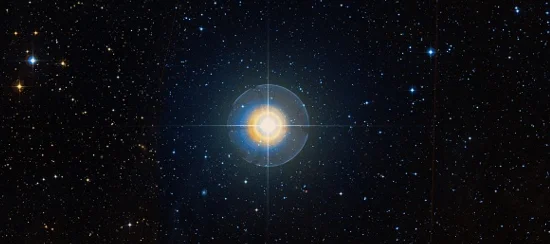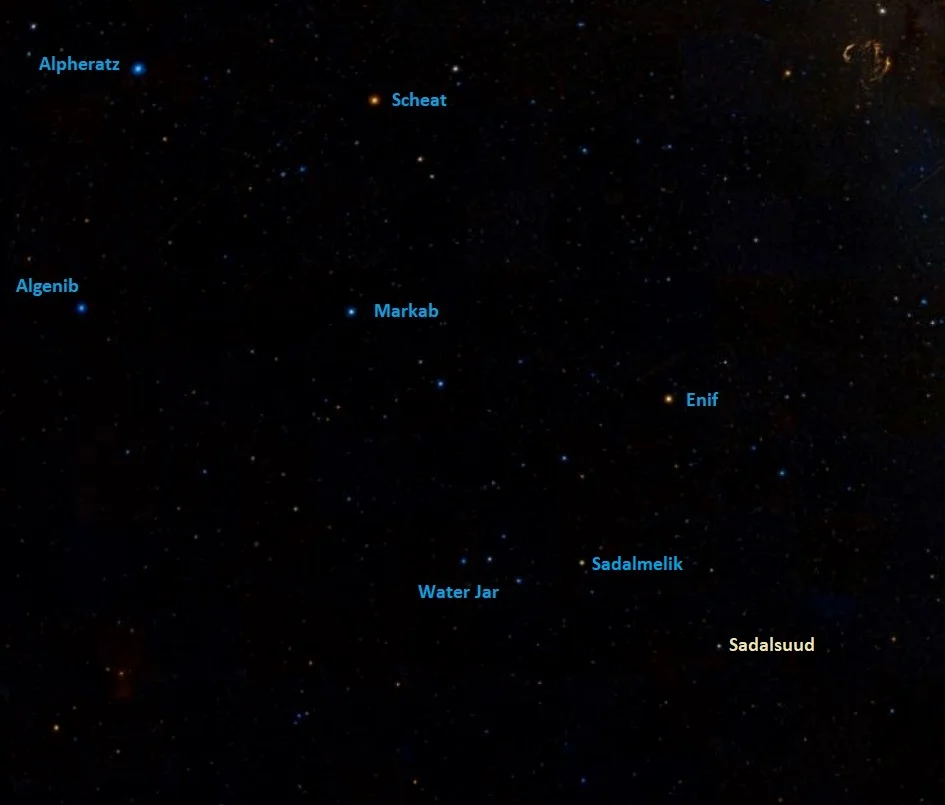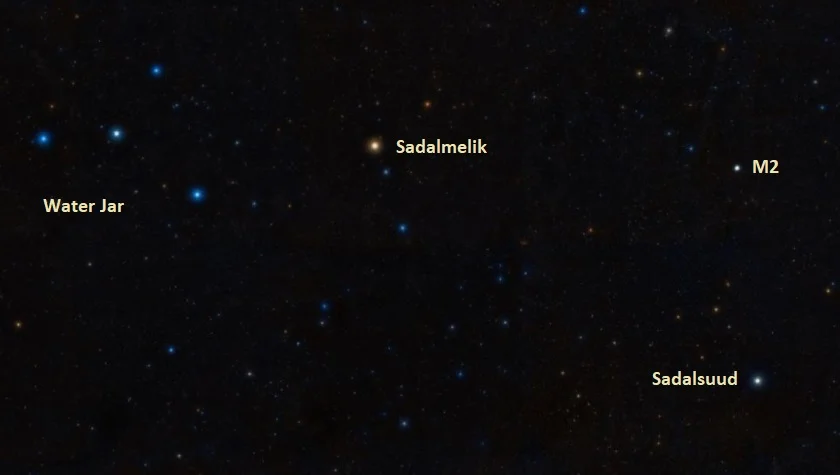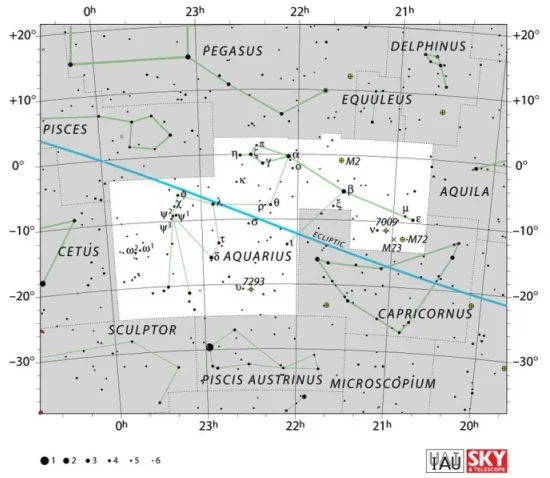Sadalsuud, Beta Aquarii (β Aqr), is a yellow supergiant star located in the constellation Aquarius. With an apparent magnitude of 2.87, it is the constellation’s brightest star, narrowly outshining the fellow supergiant Sadalmelik. Sadalsuud lies at an approximate distance of 540 light years from Earth.
Star type
Sadalsuud is a yellow supergiant of the spectral type G0 Ib. It has a mass 4.97 times that of the Sun and has expanded to a size of 47.88 solar radii. With an effective temperature of 5,608 K, it is about 2,046 times more luminous than the Sun. The star is a relatively slow spinner, with a projected rotational velocity of about 6.3 km/s. Its estimated age is 110 million years.
Even though Sadalsuud is a young star, it has evolved quickly due to its high mass. With a mass about five times that of the Sun, it is not massive enough to go out as a supernova. It will instead end its existence as a massive white dwarf.

Sadalsuud (Beta Aquarii), image: Wikisky
Facts
Sadalsuud has served as a spectral standard for its class (G0 Ib) in the Morgan-Keenan classification system since 1943. The MK system of spectral classification is used to classify stars based on the appearance of their spectra.
A study published in 2005 reported detecting coronal X-rays from Sadalsuud and its neighbour Sadalmelik. Observations with the Chandra X-ray Observatory yielded the first definitive X-ray detection of coronal emissions from G-type supergiants.
The Bright Star Catalog notes that Sadalsuud, Sadalmelik and Enif (Epsilon Pegasi) form an OB group and have space motions that carry them almost perpendicular to the Milky Way plane. The three stars are not physically bound. However, Sadalsuud and Sadalmelik are similar. They are both G-type supergiants lying at similar distances, with masses about five times that of the Sun, radii about 50 times solar, and luminosities just over 2,000 times that of the Sun. Enif, on the other hand, is an orange (class K) supergiant over 150 light years more distant and much more luminous.
Sadalsuud has two faint visual companions. Both stars are invisible to the unaided eye. They have apparent magnitudes of 11.0 and 11.6. The stars are not physically related to Sadalsuud. They do not share a common proper motion with the supergiant. In 2018, Gaia Data Release 2 showed them to be about twice as distant as Sadalsuud.
Name
The name Sadalsuud (pronunciation: /ˌsædəlˈsuːəd/) is derived from the Arabic sa‘d al-su‘ūd, meaning “the luck of lucks.” The name refers to the star’s rising with the Sun after winter has passed, signalling the beginning of a more moderate rainy season. In ancient times, Sadalsuud was associated with the coming of spring and the prosperity that the season brings. The name was historically also spelled Sadalsund, Sad es Saud, and Saad el Sund. The 17th century Egyptian astronomer Al Achsasi al Mouakket called the star Nir Saad al Saaoud in his Calendarium. The name was translated into Latin as Lucida Fortunæ Fortunarum (“the brightest luck of lucks”).
The name was officially approved by the International Astronomical Union’s (IAU) Working Group on Star Names (WGSN) on August 21, 2016.
In Arabic astronomy, the name also applied to the 22nd Arabic lunar mansion, which also included the stars Xi Aquarii (Bunda) and 46 Capricorni (c Capricorni). In Persian astronomy, Sadalsuud and Xi Aquarii formed the lunar mansion known as Bunda, from which the latter takes the name.
The Chinese know Sadalsuud as 虛宿一 (Xū Sù yī), the First Star of Emptiness. The Chinese Emptiness (or Ruins) asterism is formed by Sadalsuud with Kitalpha (Alpha Equulei). It is part of the larger Emptiness mansion, one of the northern mansions of the Black Tortoise.
In Hindu astronomy, Sadalsuud was known as Kalpeny. The origin of the name is unknown. In Euphratean astronomy, the star was called Kakkab Nammaχ, meaning “the star of mighty destiny.” This may have been the origin of the Arabic Al Sa’d al Su’ud.
Location
Sadalsuud is easy to find because it is relatively bright and lies in an area of the sky that contains two conspicuous asterisms: the Great Square of Pegasus and the Y-shaped Water Jar in Aquarius. Formed by Algenib, Scheat and Markab in Pegasus with Alpheratz in Andromeda, the Great Square dominates the constellation Pegasus. It makes it easy to identify Enif, the constellation’s brightest star, which lies just west of the asterism. Sadalsuud forms a roughly equilateral triangle with Enif and Zeta Aquarii, the central star of the Water Jar.

Sadalsuud location, image: Wikisky
Alternatively, Sadalsuud can be found by first identifying Sadalmelik, which lies along the imaginary line extended from Alpheratz, the top left star of the Great Square, through Markab, the bottom right star of the asterism. Sadalsuud is located just southwest of Sadalmelik.
The two supergiants can be used to find Messier 2, a bright globular cluster that appears about five degrees north of Sadalsuud and forms a right-sided triangle with the two stars. Messier 2 is one of the largest globular clusters known. It has an apparent magnitude of 6.3 and occupies 16’ of the sky. It once belonged to a dwarf galaxy, known as the Gaia Sausage or the Sausage Galaxy, which was devoured by the Milky Way some 8 – 11 billion years ago. The cluster lies at a distance of 55,000 light years from Earth. Its estimated age is 13 billion years.

Sadalsuud, Sadalmelik and Messier 2, image: Wikisky
Constellation
Sadalsuud is located in the constellation Aquarius. Aquarius is the 10th largest constellation in the sky, stretching across 980 square degrees. Located predominantly in the southern celestial hemisphere, it is one of the equatorial constellations, along with the neigbouring Aquila, Cetus and Pisces.

Aquarius constellation map by IAU and Sky&Telescope magazine
Even though it is large, Aquarius is not particularly conspicuous in the sky since none of its stars make the list of the 150 brightest stars in the sky. Only the two brightest stars, the luminous supergiants Sadalsuud and Sadalmelik, are brighter than magnitude 3.00.
Like other constellations in the zodiac family, Aquarius is one of the Greek constellations, first catalogued by Ptolemy of Alexandria in his Almagest in the 2nd century CE. In Greek mythology, the constellation is associated with Ganymede, the cup bearer to the Olympian gods, and with Deucalion, the son of Prometheus who survived the great flood and fathered Hellen, the mythical progenitor of the Hellenes (Greeks).
In addition to Sadalsuud and Sadalmelik, notable stars in Aquarius include the binary stars Gamma Aquarii (Sadachbia) and Delta Aquarii (Skat), the triple star Zeta Aquarii, the symbiotic star R Aquarii, TRAPPIST-1, an ultra-cool dwarf that hosts a system of seven rocky exoplanets, the nearby red dwarf Gliese 876 with four planets (including a terrestrial one), and the orange giant 91 Aquarii with a planet 2.9 times the size of Jupiter.
The constellation is home to several well-known deep sky objects: the globular clusters Messier 2 and Messier 72, the planetary nebulae NGC 7293 (the Helix Nebula) and NGC 7009 (the Saturn Nebula), the peculiar galaxy NGC 7252 (the Atoms for Peace Galaxy), and the Aquarius Dwarf Galaxy, a faint member of the Local Group.
The best time of year to observe the stars and deep sky objects in Aquarius is during the month of October, when the constellation rises high in the evening sky. The entire constellation is visible from locations between the latitudes 65° N and 90° S.
The 10 brightest stars in Aquarius are Sadalsuud (Beta Aqr, mag. 2.87), Sadalmelik (Alpha Aqr, mag. 2.942), Skat (Delta Aqr, mag. 3.28), Zeta Aquarii (mag. 3.65), 88 Aquarii (mag. 3.679), Lambda Aquarii (mag. 3.722), Albali (Epsilon Aqr, mag. 3.77), Sadachbia (Gamma Aqr, mag. 3.849), 98 Aquarii (mag. 3.97), and Eta Aquarii (mag. 4.04).
Sadalsuud – Beta Aquarii
| Spectral class | G0 Ib |
| U-B colour index | +0.58 |
| B-V colour index | +0.84 |
| Apparent magnitude | 2.87 |
| Absolute magnitude | –3.04 |
| Distance | 540 ± 20 light years (165 ± 6 parsecs) |
| Parallax | 6.07 ± 0.22 mas (Gaia: 7.0612 ± 0.5658 mas) |
| Radial velocity | 6.451 ± 0.0014 km/s |
| Proper motion | RA: +18.77 ± 0.27 mas/yr (Gaia: +23.701 ± 1.193 mas/yr) |
| Dec.: –8.21 ± 0.21 mas/yr (Gaia: -12.810 ± 0.931 mas/yr | |
| Mass | 4.97 ± 0.10 M☉ |
| Luminosity | 2,046 ± 180 L☉ |
| Radius | 47.88 R☉ (46.07 – 49.56 R☉) |
| Temperature | 5,608 ± 71 K |
| Metallicity | -0.03 dex |
| Age | 110 ± 10 million years |
| Rotational velocity | 6.3 ± 1.3 km/s |
| Surface gravity | 2.05 cgs |
| Constellation | Aquarius |
| Right ascension | 21h 31m 33.5317148s |
| Declination | –05° 34′ 16.232006″ |
| Names and designations | Sadalsuud, Beta Aquarii, β Aqr, 22 Aquarii, HD 204867, HR 8232, HIP 106278, BD–06 5770, FK5 808, SAO 145457, PPM 205297, GC 30137, GCRV 13530, JP11 3357, PLX 5188.00, IRAS 21289-0547, 2MASS J21313352-0534161, UBV 18530, TYC 5216-1725-1, Gaia DR2 2671038928727498880, ADS 15050 A, CCDM J21316-0534A, IDS 21263-0601, WDS J21316-0534A |